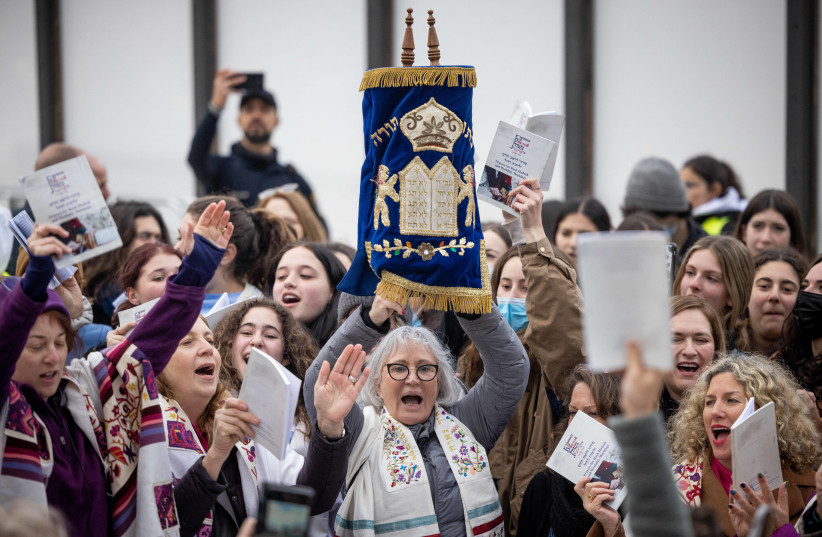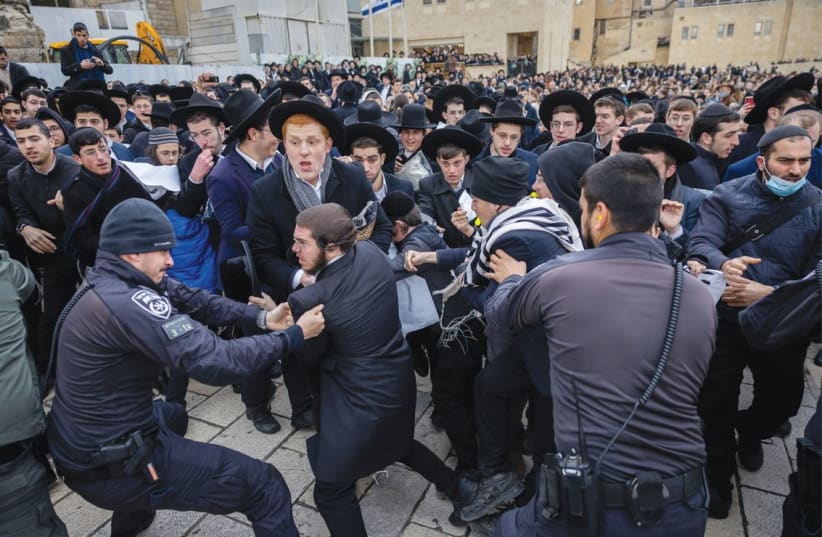On a vacation in Italy, my husband and I were walking through a piazza in Rome, when a stranger came up behind us and whispered to my husband in Hebrew. “Take off your kippah or put on a hat. It’s not safe here.”
That scene flashes through my mind on the first of the Hebrew month of Adar Bet, not in Rome but in Jerusalem. I am about to whisper the same warning to a colleague who is visiting from America.
I stifle it. As an Orthodox woman, I even refuse to take off my hat at airport security.
This is Jerusalem, my hometown, where you should be safe wearing whatever head covering you desire.
My colleague, a frequent visitor to Israel before the pandemic, wants to celebrate her return by joining the Women of the Wall for its monthly prayers at the Kotel. There is no way I, the local, am going to let her navigate this experience unescorted.


We meet at her hotel at 6 a.m. on a hazy winter morning. Hayim, the veteran cabdriver who starts his daily shift at 4 a.m., is puzzled by the unusual number of cars and buses propelling toward the Kotel.
He hasn’t heard about the calls for protest at Judaism’s holiest site. Representatives of the Conservative and Reform movements are joining the Women of the Wall. Haredi rabbis have reportedly summoned followers to protect the Kotel from this sacrilege.
A LITTLE history. Thirty-four years ago, in 1988, at the First International Jewish Feminist Conference, held in Jerusalem, the late Rabbanit Rivka Haut and Norma Baumel Joseph, both Orthodox leaders, suggested organizing a women’s group prayer at the Western Wall. Women from all religious streams and orientations prayed together. When the conference delegates left, local women continued – and have continued – to pray at the Wall on the first day of each Hebrew month, rain or shine, peace or war.
The Women of the Wall has split into two: the Original Women of the Wall and the Women of the Wall. Members of the latter have recently linked their desire to pray openly at the Kotel with that of Conservative and Reform Jews, the majority of Jews in the Diaspora. The non-Orthodox movements want the right to pray at the Kotel following their own customs, and are frustrated by the government’s refusal to carry out the agreed-upon 2016 Kotel compromise.
In 1988, it was unusual to hear an Orthodox woman read the Torah anywhere, let alone in the vicinity of the Kotel. Today, there are some 50 “partnership Orthodox” congregations in Israel where women are among the Torah readers. Shira Hadasha in Jerusalem recently marked 20 years since its founding. Nonetheless, throughout these decades, at the Kotel, women’s group prayers and Torah readings have often encountered vocal and sometimes physical harassment.
There have also been shameful police detentions for the crime of a woman reading the Torah or wearing a tallit.
MY COLLEAGUE, the CEO of Hadassah, the largest Diaspora women’s membership organization, has been asked to carry a Torah scroll. I have the organization lawyer’s phone number with me, in case she’s arrested.
But concern of possible arrest is soon dwarfed by a greater anxiety. When Hayim leaves us off near Dung Gate, long lines of modestly attired teens and young adults are striding up the hill toward the Kotel. Hundreds. Multitudes. The first legion that passes us is high school girls. Never before have I been anxious at the sight of Jewish girls.
My colleague has been advised to meet at the Azarat Yisrael, the space south of the Western Wall Plaza, close to Dung Gang, where several weeks ago one of my grandsons put on tefillin, described in these pages (www.jpost.com/opinion/article-698529).
But today, the atmosphere is different. Men with long sidelocks and large crocheted kippot are carrying partitions down the narrow steps into the courtyard, seemingly to set up barriers for women in the space reserved for egalitarian prayer. That’s prohibited, of course, but the police face greater challenges today.
Leaders of the Conservative and Reform movements – mostly men from abroad – take the Torah scrolls from the egalitarian supply. My colleague is handed one, too. A heavy one. She carries it up the stairs, where there are some hundred followers, mostly young people, but also several MKs.
Almost immediately, our group is stopped at the security entrance. Umbrellas cover the Torah scrolls as sprinkles fall. After about 20 minutes in which the group members sing the “When Adar arrives, joy is multiplied” and other familiar songs, we are allowed in after an Israeli airport-level everything-out-of-your pockets inspection.
On the other side of the barrier, the group is contained in a narrow strait at the entrance to the plaza. This seems absurd until I look around. The hundreds of fuming young men and women have turned into thousands. Every rooftop facing the plaza is lined with spectators waiting and watching.
Why aren’t they praying?
I recite with fervor the prayer for rain. Maybe most will go away if the skies open.
The police form a protective barrier. They have decided to contain the smaller group in a manner in which they can be shielded. The screeching whistles and catcalls are a distant sound.
The women move up front. With thousands of pairs of eyes fixed on the women praying, I am hoping that the prayer service itself will be inspirational and eye-opening. Disappointingly, it isn’t.
My colleague and I decide to leave just before the assemblage disperses.
She is still wearing her midnight blue kippah behind the crown of her head. It matches her long coat. Maybe no one will notice, but I know I’m fooling myself.
Waiting beyond the police barriers are young men in black pants and white shirts.
There’s not a single cab at the usual place at the turn of the road. An armed police officer suggests we walk down to the Dung Gate.
A minute’s walk. A long minute.
“Go back to America!” they shout at us.
Some spit.
“You’re not Jewish,” one calls over and over.
But the worst – with a face screwed up and burning eyes: “Die! You shall die!”
A lone cab waits beyond the gate. Driver Mohammed motions us to get in fast. Away we go, up the hill where the Levites once assembled to sing. My colleague hails from generations of Jewish musicians.
Later in the day, on Israel Radio, I hear Rabbi Yisrael Meir Lau recounting how he once praised the Lubavitcher Rebbe for bringing distanced Jews closer. The Rebbe gently corrected him. “We must bring all Jews closer. Who of us knows who is far away and who is close?”
Who indeed?
The writer is the Israel director of public relations at Hadassah, the Women’s Zionist Organization of America. Her latest book is A Daughter of Many Mothers.
